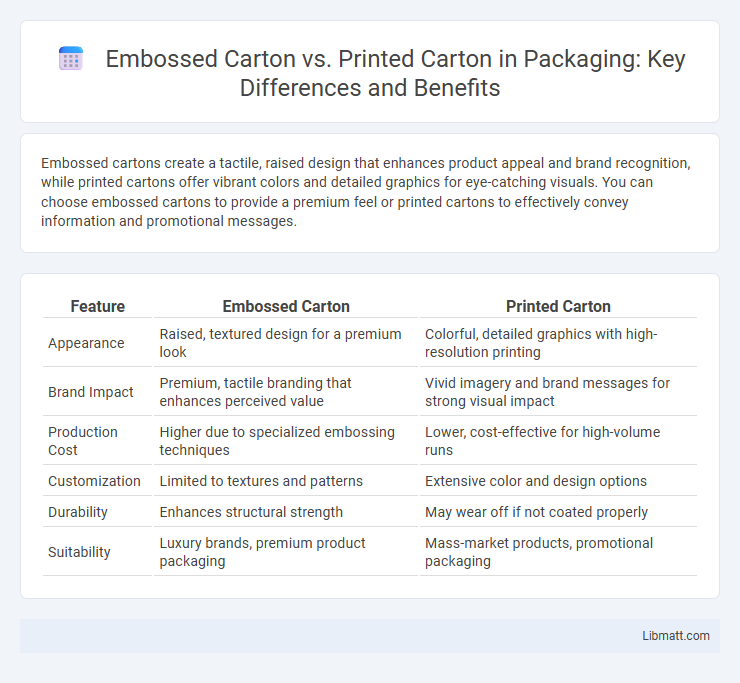Embossed cartons create a tactile, raised design that enhances product appeal and brand recognition, while printed cartons offer vibrant colors and detailed graphics for eye-catching visuals. You can choose embossed cartons to provide a premium feel or printed cartons to effectively convey information and promotional messages.
Table of Comparison
| Feature | Embossed Carton | Printed Carton |
|---|---|---|
| Appearance | Raised, textured design for a premium look | Colorful, detailed graphics with high-resolution printing |
| Brand Impact | Premium, tactile branding that enhances perceived value | Vivid imagery and brand messages for strong visual impact |
| Production Cost | Higher due to specialized embossing techniques | Lower, cost-effective for high-volume runs |
| Customization | Limited to textures and patterns | Extensive color and design options |
| Durability | Enhances structural strength | May wear off if not coated properly |
| Suitability | Luxury brands, premium product packaging | Mass-market products, promotional packaging |
Understanding Embossed Cartons: Definition and Features
Embossed cartons feature raised patterns or designs pressed into the cardboard, creating a tactile and visually striking texture that enhances brand perception. This technique adds depth and luxury to packaging, setting it apart from standard printed cartons which rely solely on ink and color for visual appeal. Understanding embossed cartons helps you choose innovative packaging that elevates product presentation and customer experience.
What Are Printed Cartons? Key Characteristics
Printed cartons feature detailed graphics, logos, and product information directly printed onto the carton's surface using various printing techniques such as offset, flexography, or digital printing. Key characteristics include vibrant colors, sharp images, and the ability to convey brand messaging and product details clearly to enhance consumer appeal and shelf visibility. These cartons offer versatile customization options and cost-effective production for high-volume packaging needs.
Differences in Manufacturing Processes
Embossed cartons are created by pressing a raised or recessed design onto the carton surface using specialized embossing rollers or plates, which adds texture and dimension without altering the carton's color. Printed cartons involve applying ink or print layers directly onto the flat carton surface through processes such as flexography, lithography, or digital printing, allowing for detailed imagery and vibrant colors. The key manufacturing difference is that embossing modifies the physical surface texture through mechanical means, while printing introduces visual elements via ink deposition on a smooth substrate.
Visual Appeal: Embossed vs Printed Cartons
Embossed cartons create a tactile, three-dimensional effect that enhances brand perception through subtle sophistication and premium appeal, making packaging stand out on retail shelves. Printed cartons offer vibrant, detailed graphics and full-color versatility, allowing for complex designs and eye-catching visuals that convey product information effectively. The choice between embossed and printed cartons depends on balancing tactile luxury against visual complexity for targeted consumer engagement.
Durability and Structural Integrity
Embossed cartons enhance durability and structural integrity by increasing rigidity through raised patterns, which add strength to the carton walls and reduce the risk of crushing during transit. Printed cartons focus primarily on visual appeal but may offer less impact resistance compared to embossed designs, making them more susceptible to dents and deformation. Your choice should reflect the need for robust protection during shipping versus the desire for vibrant branding.
Branding Impact: Creating Unique Packaging
Embossed cartons enhance branding impact by adding tactile dimension and visual depth, making packaging stand out on shelves through unique texture and light interplay. Printed cartons offer vibrant color schemes and intricate graphics that clearly communicate brand identity and product information, increasing consumer recognition. Combining embossing with printing elevates packaging by merging sensory appeal with detailed design, creating memorable and distinctive brand experiences.
Cost Comparison: Embossed vs Printed Cartons
Embossed cartons typically incur higher production costs due to specialized dies and longer setup times, making them more expensive than printed cartons. Printed cartons offer a cost-effective solution with faster turnaround times and lower material expenses, especially for large volume orders. Businesses aiming to balance visual impact with budget constraints often prefer printed cartons for economical packaging without sacrificing branding quality.
Environmental Considerations for Both Carton Types
Embossed cartons typically use less ink and fewer chemical treatments, reducing their environmental impact compared to printed cartons that often require extensive ink and solvent applications. Both carton types can be made from recyclable materials, but your choice should prioritize cartons certified for sustainability and biodegradable components. Opting for embossed cartons can support eco-friendly packaging by minimizing waste and promoting easier recycling processes.
Ideal Applications for Embossed and Printed Cartons
Embossed cartons are ideal for luxury packaging, premium products, and items requiring tactile branding to enhance customer experience and perceived value. Printed cartons suit mass-market goods, promotional packaging, and detailed graphic displays where vibrant colors and intricate designs are essential to attract consumer attention. Your choice depends on whether texture and elegance or vivid visuals and cost-efficiency better align with your product's market positioning.
Choosing the Right Carton for Your Product
Selecting the right carton between embossed and printed options depends on your product's branding and protection needs. Embossed cartons offer a tactile, premium appeal that enhances brand perception and provides a luxurious unboxing experience. Printed cartons allow for vibrant color displays and detailed graphics, ensuring clear product information and eye-catching shelf presence.
Embossed carton vs printed carton Infographic

 libmatt.com
libmatt.com